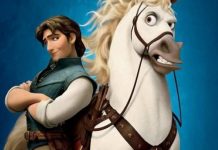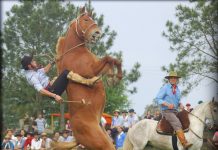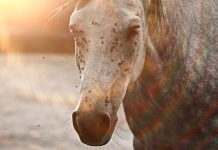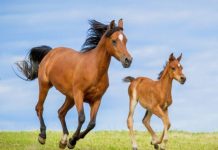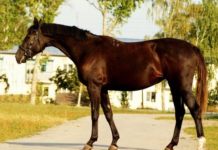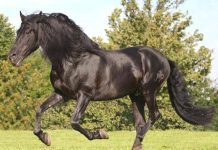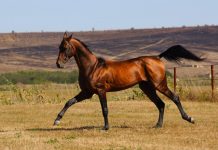The Aalstrich Pferd horse is not a separate horse breed but can be found in all horse breeds that still have a lot of “original wild horse” in their genes.
Because the Aalstrich Pferd is one of the wild color badges that identify its wearer as a member of a horse breed that is still very little influenced by breeding.
If you want to ride or buy a horse that is as natural as possible, the eel line horse is very interesting for you.
Breed description

To understand why an eel line horse is a good horse, it is necessary to briefly look at how a horse breed is bred: Horse breeds are created by crossing horses for certain characteristics and traits.
In a good, responsible breed, the characteristics (the “inner values”) are always in the foreground. The aim of such breeding is always to preserve the full range of good genes in the breed.
If the corresponding horse breed is to be particularly suitable as a jumping horse or driving horse, etc., sires with characteristics that promote this goal are primarily selected.
Often, horses of other types/breeds are crossed for this purpose in order to add certain characteristics to the original breed, which is called “refining”.
But there was and is a lot of careless breeding with poor breeding results. Critical is z. B. to consider any breed in which the main focus is on external characteristics and not on the actual characteristics of the respective horse.
Torture breeding is prohibited under the Animal Welfare Act, but the demarcation is fluid. In its details, this topic is of course much more complicated – only the generally applicable, scientifically proven basics have just been described.
In these details, however, dubious or uninformed breeders will also find reasons for their selection of breeds.
If you want to know whether a breed has been bred well or partially “bred”, you should therefore always ask one or more independent veterinarians and, if necessary, animal rights activists.
With the properties and traits that are particularly encouraged in breeding, other properties and / or traits are usually inextricably linked.
It often has bad results when bred “for color”: Appaloosa piebalds are sometimes night-blind, light Rocky Mountain horses with white eyelashes often show malformations of the eyes, “Splashed White” paint horses are often deaf, etc.
If you are interested in a horse from an original, healthy, genetically broad, and well established horse breed, the eel line horse is a really interesting horse for you:
Size: 80 – 170 cm
Origin: Germany
Lifespan: 20-30 years
Color: Duns, browns, dark browns, blacks
Suitable as: leisure
Origin and breed history
The special coat pattern on the eel line horse refers to the times when horses were still running around wild, long before the first horse breeds were created through human breeding.
This breeding by humans has long been a kind of game of chance: The most beautiful, fastest, most sociable etc. horses were crossed, but the results always resulted in unpleasant surprises.
After Georg Mendel had given people an inkling that inheritance is mediated by genes, such surprises were thought of with the expression: “Something went wrong again”. Until recently, however, avoiding such surprises was a matter of instinct and experience.
Today attempts are being made to better steer breeding in a direction that is unplanned, taking into account the genetic basis. excludes unpleasant results. At least that is attempted in the areas of breeding, where the breeding of healthy animals takes precedence over the pursuit of profit.
However, there are also breeds which, according to the latest scientific findings, should actually not be bred any further, but are still maintained because a separate line of business has now developed around these breeds.
The more detailed research is carried out into the effects of the individual genes, the better the chances of positive control. This is where the horse eel line comes into play: What a gene does is documented by recording the changes caused by breeding or mutation compared to the wild type.
So the changes that did not occur in horses in the wild or at least did not prevail in the struggle for survival.
In nature, all horse colors that make a horse a “conspicuous victim” (light-colored or white horses are eaten faster than their inconspicuous neighbors) or cause health problems (if a horse does not detect an attacker until late due to visual impairment) have not prevailed. is it bad off too).
The “normal primitive horse” is best protected as a flight animal when it blends in with its surroundings as well as possible and is healthy enough to quickly notice enemies and run away from them.
In our latitudes, a horse melts best with its surroundings when it has a medium brown coat that is as inconspicuous as possible.
It is precisely with this medium-brown coat color that the trait “eel line horse” is genetically linked – one of several wild-colored traits, including stripes of color on the legs, dark shoulder cross and flour mouth are part of it.
This medium brown color with eel line horse, different leg color, and possibly other characteristics had the fur of our primitive horses, e. B. in the Przewalski horse it can still be observed.
All horse breeds that are still very close to these primitive horses also have this color and the characteristics associated with it. The eel line horse is, so to speak, the proof that humans have so far changed very little in the corresponding horse breed through breeding.
This is not limited to the genes that determine the color, because it is hardly possible to change a horse decisively through breeding without influencing these genes as well.
The appearance of Aalstrich Pferd horse
An eel line horse usually belongs to a breed of horse that is quite similar in appearance to the original appearance of wild horses.
The wild horses on which we can still see this wild color badge today are z. B. Dülmen wild horse, Przewalski horse, and Tarpan (meanwhile exterminated, could be photographed before).
Most of the horse breeds that are genetically very close to wild horses are original pony breeds:
– American Curly Horses
– Bali pony
– Dülmener (ponies that could not stay in the Dülmener herd, e.g. due to lack of space)
– Exmoor pony
– Highland pony
– Konik
– Norwegian fjord horse, Norwegian
– Portuguese Sorraia
– Russian Bashkirs
– A dairyman horse
– Many more original races and all mixtures in which the genes of such races have prevailed
What all these breeds have in common is that the eel line horse is common here. All of these breeds also produce strong, muscular small horses that stand on straight, stable legs with strong bones and healthy joints.
The strong horses usually have strong, broad shoulders, strong necks, and deep, well-developed chests. The chest goes over an elastic, stable back into a flat to normal withers.
The head is not too small and straight; with a broad forehead and small, pointed, mobile ears. The alert, calm, expressive eyes perceive every movement in the environment, the large nostrils smell every smell from afar.
Temperament and essence
Every Aalstrich Pferd from one of the pony breeds mentioned that is close to the wild horse is usually very “clear head”. Just as horses are original: friendly and insensitive, with a balanced temperament and a strong character.
With these natural horses you almost never have problems with the character if you treat and nourish your eel line horse as a real horse is entitled to:
Husbandry and nutrition

Attitude
The pony breeds, which have not yet been changed much by breeding, are characterized by the fact that they have few demands on their keeping.
Regardless of whether it belongs to the American Curly Horses, Bali ponies, or the Norwegians, the eel line horse loves to romp around half the day on the pasture with fellow animals and spends the other half of the day eating.
When that is not possible, the natural small horses need as much natural exercise and activity as possible.
Although they do not value luxury at all: The stable can look whatever it wants, the main thing is that it protects against rain and doesn’t smell of any paintwork.
The harrow does not have to be made of pink plastic with star stickers; Fragrant natural wood is much nicer and can be nibbled on if you are bored.
Nutrition
In “nature boys” like the eel line horse, the usually somewhat rounded belly can usually handle the complicated digestion of the horse quite well.
First of all, this means that the eel line horse will almost certainly be fine with any normal horse nutrition.
The prerequisite is, of course, that it is really a normal horse diet, which, according to the most modern (and ancient) standards, consists of a lot of roughage, regular juice feed and little concentrated feed.
Roughage consists of hay straw, but also of herbs that have dried up on the stalk and other edible “scrub” (it has been observed that the Przewalski horses eat the dried leaves of the bushes in their vicinity in winter).
It is the portion of the feed that provides the large intestinal tract with the necessary mass and that also occupies the eel line horse for a good part of the day.
Water-rich juice feed is always welcome in between, it can only make the mass in the intestine smoother.
An eel line horse eats apples, carrots, beets and beetroot and every other vegetable and fruit that could be reached in its natural environment.
You can try a lot with fruits and (root) vegetables, in case of doubt you just have to deal a little with the origin of a plant.
Example:
– Our large strawberries were bred from forest strawberries and large-fruited American strawberries, neither of which were part of the daily diet of natural horses
– Doesn’t mean that an eel line horse doesn’t like to try a strawberry, but that’s not really natural food
– Sugar beets used to be quite ordinary beets, until the sugar content was greatly increased through breeding
– Many horses still like to eat, but if not only molasses-free (unmellassed) beet pulp with a low sugar content is fed, the horse will soon “roll”
– When you try it out, you can often even learn something about the naturalness of the corresponding type of fruit
– The shriveled, blotchy apple or the strawberry of a very old cultivar disappear from the palm of your hand in no time at all
– The heavily sprayed “Pink Lady”, derived from the “perfume” apple Golden Delicious, and the large, red, tasteless supermarket strawberry sometimes just stay there
The most problematic is the concentrated feed, especially with the eel line horse, which often neither in nature nor in its breed history had much to do with this high-calorie food.
If concentrated feed at all, then it has to be adjusted very precisely to the performance of the eel line horse; and the feeding of a small horse possibly coming from robust housing has its pitfalls anyway.
Education and care
Upbringing
An Aalstrich Pferd horse is usually balanced and sociable, which is why getting used to a new stable usually presents few problems.
But don’t forget: Horses smell much better than humans, especially the eel line horse, which in the truest sense of the word still has all of its senses together.
The eel line horse wants to sniff out its new surroundings in peace and quiet, and you should definitely give it the time to do so. If something is recognized as familiar by its smell, it will never frighten your horse again.
You can also count on a horse that is very close to nature that it has retained a kind of memory of the self-determined life in the great outdoors.
This usually comes with a strong character. When such a horse gets into situations in which it just doesn’t understand “modern civilization”, it often wants to “discuss” anyway.
Then you need a lot of ingenuity and a lot of patience with such self-confident horses to get them to act on your behalf.
An eel line horse can be used as a “natural horse” in all areas that suit its physique and temperament.
These are all disciplines in which a horse is moved in a species-appropriate manner, and today, again, increasingly, tasks in landscape maintenance. So driving in front of an appropriate carriage, riding in all directions, hiking with a load frame on your back, and much more.
You should not expect an eel line horse to face high and narrow obstacles that are not appropriate to the species. You could even move an Aalstrich Pferd horse to very difficult dressage tasks because these were in principle all developed from natural physical abilities.
However, only a vain stallion will in the long run prefer this horse ballet to leisurely strolling in nature, and it is not exactly easy to hold.
Maintenance
The fairly natural fur of the eel line horse is usually just as easy to care for as the healthy hooves.
It will only look a bit scruffy more often, because z. B. the change of coat still works really well and naturally and because an eel line horse as a nature boy naturally shows little fear of wallowing in beautiful muddy puddles.
Doesn’t matter, cleaning is part of it and is also gladly accepted by an eel stroke horse as a massage unit and pleasant communication with its humans. What else is involved in horse care depends on how you usually keep your horse busy.
It should always be kept clean (but not too clean and not smelling of perfume); and the whole horse should be constantly inspected to see if there are any signs of undesirable developments.
It is best to first discuss what to do then (and before you call the vet) with experienced horse experts.
Health and Typical Diseases
Little change through breeding is usually good for the horse’s health. With regard to the original pony breeds, which often have an eel line horse, this is all the more true.
They are usually small horses and therefore “normal size” horses. Very few people are aware of it: the normal wild horse, which evolution developed a long time ago, is roughly the size of a pony.
Human breeding has increased the size of all horse breeds that produce larger horses from 1.50 m and up. The muscles are strong and well developed, the legs straight and stable, the bones strong and the joints healthy.
The wide, deep chest with well-arched ribs offers plenty of space for the heart and lungs.
If good husbandry and nutrition ensure that the eel line horse maintains this natural health, the vet will not have to be called very often for an eel line horse.
Life expectancy
After everything you have just read, you shouldn’t be surprised that the breeds that are very close to the wild horse, from which the eel line horse comes, live very long. Small horses in robust housing are even the group of horses that have the highest life expectancy of all horses.
However, in this context, reference should be made to the article on pony feeding linked above. Because this also shows that the modern robust posture often has little to do with what a horse understands by natural posture.
Buy horse breed eel line horse
Many of the original horse breeds have already been mentioned above, in which the eel line horse is quite common. There are other horse breeds in which an eel line horse is a rule rather than an exception, and an eel line horse can also arise from mixtures of such breeds.
The best way to find an eel line horse is to deal with many different horse breeds – which is certainly not bad, people generally drive better if they find out beforehand what they are actually buying.
Decision support

When you buy a horse, you take responsibility for a “pet” that is not that easy to keep. Because it cannot be kept in the house, needs a stable and much more, because of which you always have to go or drive to your horse.
However, if you live in a suitable environment and you are sure that you can live up to this responsibility – an eel line horse is certainly a good choice because you can be pretty sure that you will get a healthy horse that is still very similar to its ancestors.







